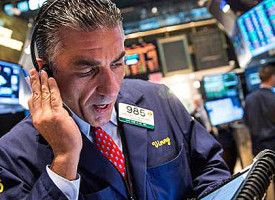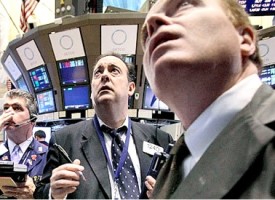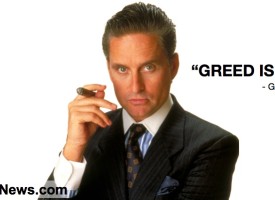With a wild start to 2016, today a legend in the business sent King World News a powerful piece about a world on the edge of chaos.
 A World On The Edge Of Chaos
A World On The Edge Of Chaos
By John Ing, Maison Placements
February 20 (King World News) – Gold bullion and gold stocks came back from the dead, attracting new money defying the rout in commodities. Gold held its value better than other assets. That previous haven, the dollar plunged sparking a scramble for safety, amid the demise of bullish market sentiment, the peaking of every market from Shanghai to Nasdaq, Middle East turmoil and concerns over the health of the global financial outlook. Although this long overdue correction was well advertised, the markets now view the glass as half empty, rather than half full…
SPECIAL LIMITED TIME OFFER FOR KWN READERS & LISTENERS:
All KWN readers and listeners who sign-up and fund a BitGold account will receive an
additional 5% bonus (up to $100.00) added to their Bitgold accounts.
Sign up today by email – CLICK HERE OR ON THE LOGO:
Fear has replaced optimism. Until recently, the market has ignored red flags for months, including oil sliding for much of last year, China’s slowdown and Japan’s adoption of negative interest rates joining the ongoing currency war. Nothing new here.
What is new is China’s use of its massive foreign exchange hoard to prop up the renminbi amid the massive selling of US debt by Russia, China and Middle East players resulting in a “cashing out” of the billions of IOUs printed by the Fed. Those dollar-denominated debts once languishing in the vaults are now coming home to roost, causing the US dollar to finally fall. The lack of growth in the US only reaffirms that the “pushing on a string” quantitative easing is not working. Expanding central bank balance sheets to lower rates has become less effective over time. And, of course the prospect of another socialist president or even The Donald was enough to send gold higher.
The rate hike? It was a non-event, partly because it was the most well-advertised event for much of the past couple years. Nevertheless, few recall that between 2005 and 2006, interest rates went up 17 times, yet gold soared 50 percent. Meantime, central banks continue to buy the yellow metal. China is buying 50 tonnes a month joining Russia and other central banks. Even the gold ETF attracted almost a billion in only a month in contrast to the $2 billion of withdrawals over the last year.
Near term, gold is technically overbought, and a brief pullback would present another attractive buying opportunity for those who missed the boat by listening to Goldman’s economists. Following that, we expect a bull run to $1,300 per ounce and then a target to the old high, yes $2,000 per ounce. Gold will be a good thing to have.
Politicization of Policy
When Mr. Obama took office, the US deficit was $10 billion and with less than a year left in his term, it is now $19 trillion or more than 75 percent of GDP, which does not include growing entitlements and Medicare bills. Debt has grown twice as much as GDP, which is unsustainable. And despite numerous government shutdowns, congressional stalemates and promises, Mr. Obama has brought out another Keynesian $4.2 trillion budget, leaving a fiscal time bomb for his successor.
However, in addition to the growing entitlement burden, the ratcheting up of debt leaves little room to maneuver in a stressed credit environment. And elsewhere? Brazil might miss a debt repayment. Venezuela is bankrupt. Puerto Rico defaulted. Despite the politicization of the budget deficit, reality must set in and bills must be paid, even though the Fed is studying following Japan and Europe into negative interest rate territory. The first rate increase in almost 10 years is an example of the politicization of monetary policy.
Unlike Alexis de Tocqueville’s concern that the biggest danger to US democracy was the tyranny of the majority, today he would have been concerned about the tyranny of the minority. It seems mainstream politics is under attack with the populist uprising a backlash against the one percenters or a Robin Hood solution of taking from the rich to give to the poor.
Although the populists’ solution of Trump and Sanders are different, the popularity of their message is not the message itself but a consequence of the politicization of economic and monetary policy such that they have become so intertwined, that the Trump/Sanders success validated the politicization of government policy. This failure has created unrealistic expectations that inevitably disappoint and thus the thirst for change. Ignoring the majority, politicians have simply created their own monster. Capitalism is under fire and policy uncertainties have created a risk premium.
 How Low Can They Go?
How Low Can They Go?
Worries about growth prompted Japan to introduce a new stage of quantitative easing by adopting negative yields, lowering rates into negative territory. In other words you pay the bank to hold your money. This experimental policy follows Switzerland, Sweden and Denmark and a quarter of government bonds today, trade below zero. Negative interest rates were last seen in the Dirty Thirties.
However, the impact on commercial banks is considerable, introducing distortions in the financial markets ruining spreads. The implications of the negative cost to holding currencies is widespread and reflects that fiat money has been constantly debased by central banks. Money is no longer money. Purchasing power is gone. On the other hand, corporate borrowers and in particular, the junk players have been paying higher rates such that the spread is the largest since the Lehman Brothers’ collapse of 2008. This is the start of an upside world. That investors are willing to accept negative rates suggests that today they are more concerned over the safety of their money and whom they have left their deposits with.
An example of the central banks’ waning credibility is that running out of options, they are caught up in a competitive currency war, a zero sum game exacerbated by negative rates. We believe that this next stage of quantitative easing reflects the shifting of the enormous surplus of money that was created and the sloshing around suggests that investors are reluctant to invest in long term projects, or even today, buy bonds. And, dividend models are about to be thrown out the window as investors become concerned that stocks are now too expensive, having been declared only too cheap, a year ago. Consequently, investors have become super-cautious seeking that safe haven, gold.
Central banks’ rock bottom interest rates policies, cannot be relied upon as the ultimate backstop, having singularly failed to resurrect their flagging economies with trillions of stimulus. The market has called Chairwoman’s Yellen’s bluff. Central bankers have lost the markets’ confidence. Quantitative easing allowed the central banks to purchase massive amounts of debt with newly printed money in order to depress interest rates which in turn was to stimulate borrowing and revive the economy. Wrong.
Instead central banks threw more money at the problem, such that their balance sheets became top heavy with debt. Those bloated reserves have crippled the banking system. Banks traditionally make money on the spread however with those assets now in negative territory, these “too big to fail” players have experienced difficulties in an “illiquid negative rate environment”. And, as China unwinds their stockpile of foreign exchange reserves in support of the renminbi, that money is beginning to work itself through the system, with dangerous implications.

Contagion is Back
An unintended consequence and not so lucky are the financial institutions that funded the oil and gas boom, in particular the shale players. Too big to fail Deutsche Bank, Credit Suisse and Wells Fargo are trading at a fraction of their peaks over concerns that non-performing losses will swamp their capital. These banks were at the epicenter of the 2008 collapse. The move to negative interest rates will squeeze bank profits and upsets the traditional banking model, removing their safety net. To no surprise the price of insurance went up again in a déjà vu moment of 2008. Wall Street lent billions to junk rated borrowers and now have worthless oil rigs and leases as collateral.
Of course Wall Street offloaded some of those liabilities in newly created structured products to their clients. Wells Fargo has $17 billion of exposure. Bank of America has $21.3 billion exposure. Italian banks are carrying almost 20 percent non-performing loans. For these ailing banks, who is going to bail them out? Last time, it was the central banks but after the Cyprus bank debacle they shifted that responsibility to the depositors in a “bailing in” move. And now the Germans have a “bail-in” plan for government bonds that could impose “haircuts” on holders, imperiling the eurozone itself. Caveat Emptor!
Regulatory Reform
Money continues to be debased. Cash itself was targeted by governments closing tax havens in the quest for revenues. Central banks are even getting rid of highly valued denominated currency. Capitalizing on this vacuum, entrepreneurs have introduced alternatives. In reaction to the increasing regulatory burden, technology has revolutionized fund raising. Bitcoin is the latest digital currency.
Blockchain technology has taken the bitcoin one step further, allowing fund raising, back office payments, and eliminating due diligence all in one click. The International Monetary Fund (IMF) itself issued its first white paper on virtual currencies. In simple terms, the use of blockchain technology is a glorified ledger enabling electronic payments giving banks huge advantages. Central banks have climbed aboard as blockchain transactions can eliminate tax avoidance, money laundering, fraud and terrorist transfers.
In other words, the old school banks are giving way to the cyberbanks. Similarly, technology could help the old stock exchanges. The truth however, is that the ultimate currency is waiting. We believe gold, which is time tested over thousands of years, will outlast the bitcoins and blockchain technology because today’s paper currencies are found wanting. History shows that stores of values are to be highly prized when there is a lack of monetary discipline. Alternatives to the dollar will gain in value. Gold anyone?
China Rising?
In the nineties, many Asian countries pegged their currencies to the dollar. This summer, China dropped the peg to the dollar in order to make the renminbi more independent and market oriented which resulted in a six percent decline. China spent more than $100 billion to support the renminbi and there are talks of capital controls. China dipped into the world largest reserves which was accumulated from years and years of trade surpluses.
While capital controls would slow the outflow, China’s growing ambitions have dictated a “going out policy” to secure needed resources via larger and larger M&A deals such as ChemChina’s $43 billion bid for Switzerland’s Syngenta. With the largest reserves in the world, China is using its financial heft to pursue a “one belt, one road” initiative of building global trade links, assisted by Chinese led financial institutions like the Asian Infrastructure Investment Bank.
While China limits renminbi outflows, one of five cross border deals totaled $157 billion. China remains the world’s largest importer of oil and the collapse in oil prices is a windfall and better than a super tax cut. The Chinese are simply capitalizing on the lower prices by stockpiling their strategic reserves and, of course becoming the world’s largest market for gas guzzlers last year. And while many point to the decline in luxury goods, the drop was due more to the ongoing crackdown on corruption and wasteful spending.
Growth in car sales, year over year are still at the highest levels in the world. China’s monthly gold purchases are a step towards making the “redback” a major currency, rivaling the greenback. We believe the authorities move to make the redback independent and break the de facto link to the American financial hegemony was because of concerns over the dollar’s long term value.
US slow growth and huge debt burdens ultimately raises questions about the repayment of that debt. The age old discipline of supply leaves the dollar only one way to go. Vast amounts of dollars are held everywhere. Gold will continue to rise in value as long as the United States keeps drifting towards fiscal instability. Their system is so debt clogged that not even a one percent yield could coax buyers.
Gold’s new bull market has just begun. As long as America consumes much more that it produces and owes much more than it owns, the avalanche of dollars will keep coming. What damages trust in the dollar, damages the world. Gold is an alternative to the dollar for central banks. We thus believe gold will continue to outperform stock markets this year, as it has for the first part of this year. Gold is that new/old global currency. ***KWN has now released the extraordinary audio interview with Dr. Marc Faber, where he discusses the greatest threat to the world, his stunning predictions for the rest of 2016, gold, and what investors can do with their money right now, and you can access it by CLICKING HERE OR ON THE IMAGE BELOW.
Also, the long awaited audio interview with London metals trader Andrew Maguire has now been released and you can listen to it by CLICKING HERE OR ON THE IMAGE BELOW.
***ALSO RELEASED: Marc Faber On Gold, Government Theft And Negative Interest Rates CLICK HERE.
© 2015 by King World News®. All Rights Reserved. This material may not be published, broadcast, rewritten, or redistributed. However, linking directly to the articles is permitted and encouraged.










